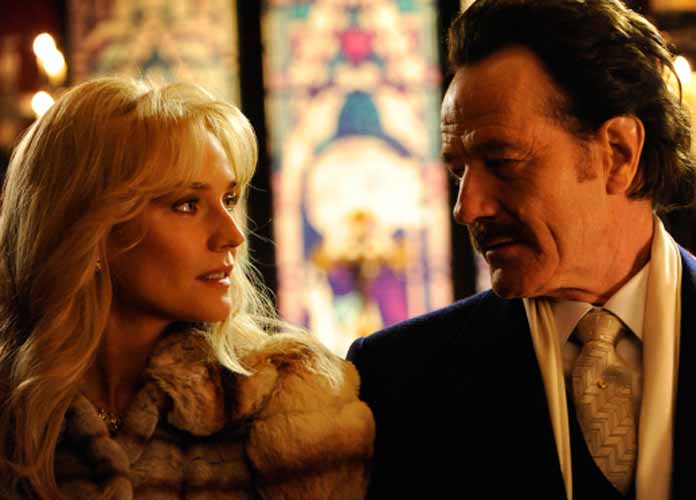‘The Infiltrator’ Movie Review: Bryan Cranston Dives Deep into the Columbian Drug Trade

3.5/5
What begins as a standard undercover-cop movie, or a Scorsese storyline sans voice-over, soon unravels into a rapid-fire tale of bloodshed, betrayal, and pure uninhibited trauma in The Infiltrator. Bryan Cranston, of Breaking Bad notoriety, takes a role on the legal side of the drugs game, as real-life special agent Robert Mazur. Chasing the top dogs behind Pablo Escobar’s infamous money-laundering business, Mazur, disguised as “Bob Musella,” worms his way into the inner circles of the ultra-wealthy—and ultra-suave—businessman behind the illegal trade. It’s while on the way to the top that the pastel stucco walls of 1986 Tampa get splattered with blood, and Mazur’s life and family are put at risk as he finds himself in-too-deep.
The film opens with Mazur already undercover on a minor drug sting, the meeting spot a comically innocuous bowling alley; one can clearly match the parallels between the brightly colored play-spaces and the frequent presence of children and children’s games throughout the story. Families are centric to this drug-narrative, making the horrors to which Mazur must bear witness all-the-more horrific. With ‘The War on Drugs’ campaigns at one point bluntly overwhelming the visual space, the film from the get-go makes the drug business commonplace in America, a function of the economy despite insistence over its removal.
When Mazur’s wire short-circuits and injures his chest, he is informed of his eligibility for retirement. Initially turned off at the thought of another case, especially at the giddy request of partner Emir Abreu, whom John Leguizamo plays with equal parts sarcasm and sadism, Mazur ultimately turns down retirement, instead seeking one final undercover mission with a simple plan; follow the money, not the drugs. Using an informant and a former criminal connection, Dominic ( Joe Gilgun), Mazur and Abreu work their way into the network of illegal money management, with Mazur’s Musella advertising his services (recalling Mazur’s frequently mentioned , safer past life as an accountant) as a more secure way to cover their tracks. Cranston’s Mazur, while confident with his lower-risk roles undercover, suffers several nail-biting blunders on the road to ascension into the inner circle, accidentally giving himself a fiancée early in the game, who later materializes as agent Kathy Ertz (Diane Kruger).
As with films before it that highlight the lives of those within the criminal underground, the drug lords Mazur surrounds himself with frequently hold their meetings at flashy night clubs, where they drink and party under neon lights and go-go dancers. Director Brad Furman makes use of these spaces, emphasizing the color and the lights to suggest an almost supernatural atmosphere (one club makes a tongue-in-cheek nod to Stanley Kubrick’s 2001: A Space Odyssey with its signage). It’s not the film’s depiction of the drug world that makes The Informant stand out, but rather the frequency of violence and how it seeps into Mazur’s personal life (like fresh blood out of a miniature coffin) that gives the film its edge. In an evening off from his double life, he takes his already frazzled wife Evelyn (Juliet Aubrey) out for a hasty anniversary dinner. Much to his horror, he is recognized as Musella and must turn into that persona, aggressively berating a waiter to cover up Evelyn’s identity. Days later, Mazur is nearly assassinated in a car attack, and nearly killed in a voodoo ritual test that looks as if it was ripped from the Texas Chainsaw Massacre franchise. At every turn, there is relentless death and destruction, and Mazur must only crawl deeper into the belly of the beast; there is never, at any point, a moment of return or resignation, and the stakes remain high throughout the middle of the film, sustained by Cranston’s simultaneous confidence as Musella and thinly masked fear as Mazur.
Once Mazur reaches the top, now with fake wife Kathy, things briefly calm down as they befriend Roberto Alcaino and family, a cocaine transporter with the trappings of a Wall Street CEO. With the faux couple welcomed into the family with open arms, Mazur and Ertz must now contend with their own consciences, the Alcainos becoming more friends than enemies. In these moments of wealth and fellowship, The Informant seems to leave the stereotypes of the violent drug world behind and create one of the more confusing emotions one can have while watching a movie about criminal activity: empathy. Gonzalo, the informant helping Mazur and Abreu, makes an early reference to The Godfather, a similarly introspective world of mobsters (see Mob Wives for a more contemporary example). As with the former, The Informant plays with the idea of normalized violence, which is just part of the job. The people heading these actions emphasize their actions as a simple way to earn a living; the Alcainos are good people, removed from the knives and guns flashing around Mazur, and that complicates things. What’s darker is how deep the network of “good” people go. Mazur’s mission includes the take down of Bank of Credit and Commerce International (BCCI), a powerful bank headed by wealthy foreign businessman, who soften their involvement with the cocaine business by simply softening their language.
The Informant follows the standard route of an undercover movie, and pulls no punches. Furman’s film however, succeeds in it’s visuals and often relentlessly traumatic depictions of violence, more so than it’s narrative. This is not a movie that relies on guns and quick stabs. As Dominic tells Mazur, the attacks are drawn out and theatrical, punctuated by quick cut-aways and exceptionally loud sound effects. Furman paints a picture that fluctuates between the colorful grittiness of the drug underground, and the white pristine spaces of the elite. The combination is unsettling.
RELATED ARTICLES
Get the most-revealing celebrity conversations with the uInterview podcast!



 Click here for the Kim Kardashian’s Most Revealing Selfies Slideshow
Click here for the Kim Kardashian’s Most Revealing Selfies Slideshow



Leave a comment